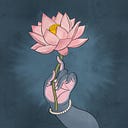Sadāśiva
Sadāśiva (सदाशिव) refers to a form of Śiva, one of the epithets of Rudra.
The Śaiva āgamas consider Sadāśiva as the highest Supreme being, beyond the comprehension of anyone — subtle, luminous and all-pervading. Sadāśiva appears with five faces: Īśāana, Tatpurusha, Aghora, Vāmadeva and Sadyojāta collectively represent the Pañcha-brahmas and are regarded to be emanations from the nishkala Śiva (the formless, unmanifested Param-brahma). The Śaivaites regard the five heads as symbolizing the soul, the material world, the Buddhi, ahamkāra and the mind.
The dhyāna of Sadāśiva occurring in Śāradātilakatantra 18.91 describes the five faces as being:
1. the colour of pearls
2. yellow
3. the colour of a rain cloud (= dark-blue)
4. the colour of mother of pearl
5. the colour of the China rose (= red).
The worship of Sadāśiva was particularly popular during the Pāla and Sena periods in Bengal. The Sena kings were Parama-Śaiva, and hence, propagated Śaivism during their reign in Bengal. Several copper-plate grants of the Sena kings bear the figure of Sadāśiva on their seals, called ‘Sadāśiva-mudra’ and ‘Sadāśivamudrāya-mudrayitvā’ in inscriptions.
This deity is sitting cross legged in a padmāsana on a double lotus pedestal, with a bull depicted in front. He has four visible heads facing the four directions and 10 hands holding trident, vajra, sword, axe and abhayamudrā on the right and snake, pāśa, bell, fire and a weapon called aṅkuśa on the left.
After the Muslim conquest of Bihar and Bengal in the first half of the 13th century, the local sculptor/artists migrated to Nepal and influenced their existing art and iconography, making this depiction common in Nepali bronzes.
“Lord Śiva is not unknowable entirely. He can be known by devotees who have no other refuge though he is unknowable through thousands of Vedic passages without devotion. So says the great Vedic passage. Sadāśiva shall be known through his own blessings by mental tranquility and supreme vision without aberrations and distractions.” Śivapurāṇa
Source: Iconography of Sadāśiva by B. N. Sharma
______________________________________________________________
If you find value in my work, I hope you consider becoming a patron through Patreon. Hindu Aesthetic requires a lot of time and effort and your support would mean that I can continue bringing you the highest quality content. Link to my Patreon:
